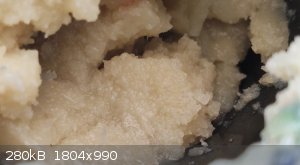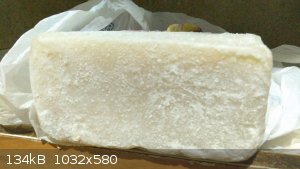palico
Hazard to Self
 
Posts: 63
Registered: 1-10-2013
Member Is Offline
Mood: No Mood
|
|
Synthesis of fatty acids from expired soap
Hello people !
today another episode of the waste to resource series. I am thinking to rename it into " Scrap chemicals from whatever ". The experiment is based on a
acid-base reaction, that is the synthesis of fatty acids by neutralization of soap.
Years ago I bought this pure olive oil soap, but since it is natural it has an expiration date, and as it looked like, I thought it was definitevely
already expired. So, why do not get all possible fatty acids from it ? I am doing this with the future intentions to esterified those fatty acids with
ethanol, so the full procedure would be a two-step solution to biodiesel from waste. I already made biodiesel from waste cooking oil, this one would be biodiesel from waste soap.
So let's find out fatty acids are really fatty.
The reaction is a simple acid-base between the sodium soap and hydrochloric acid

However, since soap producer does not remove glycerol from product, and also by expiration there were some brown insoluble material, I preferred to
pre-treat the waste soap before the neutralization reaction.
Procedure
316 grams of waste soap are weighed out, cutted in pieces, placed in a steel pot and dissolved in 3 liters of tap water.

This is filtered while still hot through a tablecloth. The hot solution is let cool overnight. The day after a precipitate is found. The suspension,
which is very viscous, is filtered again through tablecloth, but once stucked, the residue and remaining suspension is added of 2 liters of tap water
and brought to 80 Celsius to dissolve. The combined soap suspension, are almost 5 liters, are divided in two portions; to each 100 grams of sodium
chloride is added, and quickly the common ion effect, let the sodium carboxylates to precipitate out. All is left standing overnight.
The day after, a net separated suspension is obtained, with white solid floating on top. This is filtered through nylon woman socks, to avoid
clogging, then residue treated with tap water, and brine solution, let dry in open air for some hours.
The white residue obtained it suspended in 2 liters of tap water, brought to 80 Celsius. This suspension shows a pH of 10, then while still hot to
this 25 ml of concentrated HCl is added; pH goes down to 9. Other 50 ml of acid is added and a solid immediately forms, pH is now 5. Since the
suspension is still hot, the formed fatty acids melt on top. The pot is covered, and left overnight. The day after a perfect yellowish solid is found
floating on top. This is recovered carefully with a spoon, pressed on paper, let dry in open air for a morning
This waxy, oily solid is the mixture of solid and liquid fatty acids, which the latter are partially absorbed and lost on paper. The yield is 216
grams, 68.4% of initial mass, considering those losses, it is a good yield.
The acid function is tested positively with bicarbonate solution.

Discussion
Looking back, I would have avoided all those tedious dissolution, filtration and neutralized directly once the soap was dissolved in the first three
liters of tap water.
But for me it is good in this way, it is another example of chemical recycling, to get some resource from a waste. I am happy like that.
EDIT: I did not try to recover the glycerol, because evaporate 5 liters of water to get 30 grams of glycerol, it looked too much economically not
convenient to me.
The products smell of something closed in the wardrobe for long, remind something expired and old but the smell it is not unpleasant.
As usual I link you to the YT video for a more detailed procedure.
thanks for attention,
see you,
palico
[Edited on 13-3-2024 by palico]
|
|
|
chornedsnorkack
National Hazard
   
Posts: 564
Registered: 16-2-2012
Member Is Offline
Mood: No Mood
|
|
Quote: Originally posted by palico  | Hello people !
today another episode of the waste to resource series. I am thinking to rename it into " Scrap chemicals from whatever ". The experiment is based on a
acid-base reaction, that is the synthesis of fatty acids by neutralization of soap.
Years ago I bought this pure olive oil soap, but since it is natural it has an expiration date, and as it looked like, I thought it was definitevely
already expired. So, why do not get all possible fatty acids from it ? I am doing this with the future intentions to esterified those fatty acids with
ethanol, so the full procedure would be a two-step solution to biodiesel from waste. I already made biodiesel from waste cooking oil, this one would be biodiesel from waste soap.
So let's find out fatty acids are really fatty.
The reaction is a simple acid-base between the sodium soap and hydrochloric acid
However, since soap producer does not remove glycerol from product, and also by expiration there were some brown insoluble material, I preferred to
pre-treat the waste soap before the neutralization reaction.
|
What did you have besides fatty acids? Like, what do the fatty acids of the soap expire TO?
Oleate seems to have several possible reactions:
C8H17-CH=CH-C7H14COONa -> C8H17-CHOH-CHOH-C7H14COONa
C8H17-CH=CH-C7H14COONa ->OHC-C7H14COONa
2C8H17-CH=CH-C7H14COONa
->(C8H17)2C4H4(C7H14COONa)2
So which of these had happened?
[Edited on 13-3-2024 by chornedsnorkack]
|
|
|
clearly_not_atara
International Hazard
    
Posts: 2800
Registered: 3-11-2013
Member Is Offline
Mood: Big
|
|
Soap doesn't really expire. They just want you to buy more. Granted there will be some rancidity, but a lot of that probably happened during the
manufacturing process. The insoluble material is probably fragrance and wax that was used to make the soap.
Anyway nice work.
|
|
|
Ubya
International Hazard
    
Posts: 1247
Registered: 23-11-2017
Location: Rome-Italy
Member Is Offline
Mood: I'm a maddo scientisto!!!
|
|
i don't think you even need 3L of water.
i converted back 250g of soap back to the costituent fatty acids by heating it in 1L of water, adding some HCl, and check the ph until neutral.
the melted fatty acids don't stay in solution, so you don't actually need to actually dissolve the whole soap.
Anyway great job
---------------------------------------------------------------------
feel free to correct my grammar, or any mistakes i make
---------------------------------------------------------------------
|
|
|
palico
Hazard to Self
 
Posts: 63
Registered: 1-10-2013
Member Is Offline
Mood: No Mood
|
|
@chornedsnorkack: I have no idea which one those degradation reaction has occurred to my soap.
@clearly_not_atara: ehm no, there were no preservatives, fragrances and so on added, I purchased pure natural olive oil soap, I know the man who made
it, the starting olive oil was even mine. The degradation of the soap was evident. It changed color, darkened, changed smell and made a fluffy powder
similar to fungi. The soap is basic, the glycerol suffer from degradation and also the double bond of side chain can be oxidized.
|
|
|
Lionel Spanner
Hazard to Others
  
Posts: 168
Registered: 14-12-2021
Location: near Barnsley, UK
Member Is Offline
|
|
Quote: Originally posted by palico  | | @clearly_not_atara: ehm no, there were no preservatives, fragrances and so on added, I purchased pure natural olive oil soap, I know the man who made
it, the starting olive oil was even mine. The degradation of the soap was evident. It changed color, darkened, changed smell and made a fluffy powder
similar to fungi. The soap is basic, the glycerol suffer from degradation and also the double bond of side chain can be oxidized.
|
It's most likely yeast or mould. Saponified soaps are alkaline and contain very little water at the point of manufacture, but while they're in use,
they are in constant contact with unsterilised neutral water, don't absorb that water and are rarely dried after use; yeasts and moulds need
relatively little water to grow, compared to bacteria, so they can potentially form colonies over very long periods.
This can even occur in long-term storage if the product is not sufficiently protected from atmospheric moisture.
|
|
|
bnull
Hazard to Others
  
Posts: 478
Registered: 15-1-2024
Location: South of the border, wherever the border is.
Member Is Offline
Mood: "Ah, what the hell; it's Christmas!" - Carmine Lorenzo
|
|
Or sodium carbonate. It happens with homemade soaps. There's almost always an excess sodium hydroxide that gets carbonated. Like this:

This one is about eight months old, it is wrapped in a plastic bag inside a cabinet and doesn't smell (yet). The color comes from the used soybean
oil. It is slightly dehydrated.
@chornedsnorkack: It is way more complicated. The most probable is attack by free-radicals. Oxygen may: either break the double bonds, the products
being mainly octanoic acids (with and without hydroxy groups, mono- and dicarboxylic versions) and aldehydes; or form peroxides and ketones. Or even
break the double bonds and form peroxides and ketones, in the case of oleic acid, as well as forming (the smelly) butyric and propanoic acids
in the case of linoleic acid.
Quod scripsi, scripsi.
B. N. Ull
P.S.: Did you know that we have a Library?
|
|
|
palico
Hazard to Self
 
Posts: 63
Registered: 1-10-2013
Member Is Offline
Mood: No Mood
|
|
Your considerations are all correct.
|
|
|
bnull
Hazard to Others
  
Posts: 478
Registered: 15-1-2024
Location: South of the border, wherever the border is.
Member Is Offline
Mood: "Ah, what the hell; it's Christmas!" - Carmine Lorenzo
|
|
Thank you. I was into homemade soaps and fatty acids some 20 years ago.
Quod scripsi, scripsi.
B. N. Ull
P.S.: Did you know that we have a Library?
|
|
|
|